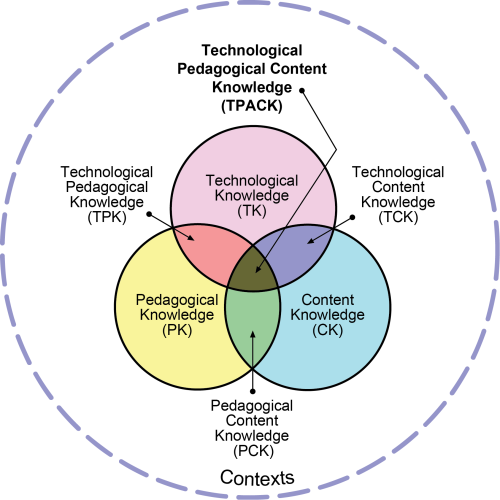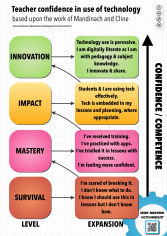“You can’t connect the dots looking forward; you can only connect them looking backwards.” (Steve Jobs)
SAMR FRAMEWORK
Until Mari mentioned SAMR in her blog a few weeks ago, I must confess to not really having much of and idea what she was talking. Though at the time, I did not want to confess my ignorance, a few weeks on and I am far less worried about admitting that I have not idea what SAMR is…how far I have come!
On watching the video David’s posted and a few Google image searches later, I seem to recall hearing about SAMR but have no idea where, when or from whom (getting old is a terrible thing) . In familiarising myself with what the framework entails, I realise that I have actually been employing these strategies in my work without consciously ever really thinking about it. Isn’t it great when you find validation of your approaches based in theory!
Since starting teaching, I have seen many trends come and go. Someone goes to an inservice and the next thing the entire world is being turned upside-down. Next month, something else comes along and the focus shifts. As time goes on, experience teaches you to think before you act. You become less interested about diligently jumping on the latest band wagon and more interested in evaluating and testing what it can add to the teaching and learning outcomes for your students. As the years creep by, your focus shifts again, and it becomes less about what to add, and more about what to substitute, augment, modify or refine about your teaching practice. The journey of my teaching career in four letters – SAMR!
In considering the SAMR model further, I recalled some articles I had downloaded for another subject on the TPACK framework. I believe the two frameworks may in fact compliment each other quite nicely.
TPACK FRAMEWORK
As I understand it, the TPACK framework consists of three main components :
- Content knowledge (CK) the “teachers’ knowledge about the subject matter to be learned or taught.”
- Pedagogical Content Knowledge (PCK) “is [the]…knowledge of pedagogy that is applicable to teaching specific content.”
- Technology Knowledge (TK)
(Koehler, Mishra & Cain 2013)
Koehler, Mishra & Cain (2013) indicate in their article ‘What Is Technological Pedagogical Content Knowledge (TPACK)?‘ that creating a definition that encompass technology is difficult due to the rapid rate a which technology evolves. The authors further suggest that their definition of TK is heavily influence by FITness – Fluency of Information Technology as developed by the Committee of Information Technology Literacy of the National Research Council (NRC, 1999 as cited in Koehler, Mishra & Cain 2013).
They argue that FITness goes beyond traditional notions of computer literacy to require that persons understand information technology broadly enough to apply it productively at work and in their everyday lives, to recognize when information technology can assist or impede the achievement of a goal, and to continually adapt to changes in information technology.” (Koehler, Mishra & Cain 2013)
What intrigues me most about the TPACK model is, what I like to call, the OPTIMAL OVERLAP of content, pedagogy and technology and the amazing opportunities this presents to us as both teachers and learners.
Granted my understanding of this framework is novice at best, but it seems to me that this should be the ideal goal for teaching and learning in an age when technology offers us unlimited possibility. It is in this optimal overlap where I can see the transformation possibilities of Modification and Redefinition really come into play. While the enhancement phases of Substitution and Augmentation, are probably more likely to be found in the area of overlap between Technological Content Knowledge (TCK) and Technological Pedagogical Content (TPK). I surmise that Modification also has a place in these two areas; however am unsure if Redefinition is possible without a combination of of all three aspect of the model; content, pedagogy and knowledge.
What I also find promising about this framework is that the technology doesn’t drive the content or the pedagogy. It allows for decisions are made based on best practice in all areas.
Of course the successful implementation of either the TPACK and SAMR framework require a commitment educators to change, develop and refine their teaching practice in new ways.
“Learning what to eliminate and what to keep is, depending upon the ladder you are climbing, is not always easy to decide.” (Bigum &Rowan, 2013)
I think it is important to acknowledge that this process can be quite confronting for people who perhaps do not feel comfortable with their own use of technology. With this in mind I share this image created by Mark Anderson based on the work of Ellen Mandinach and Hugh Cline below. I thought it was worth including, if for no other reason than to remind us that we are all standing on different rungs of ‘the ladder’ when it comes to technology.
When looking for teachers to uptake new and innovative ideas there will be those who will adapt and adopt new knowledge more easily and then there will be those who will take a little longer because they are currently position a little further down ‘the ladder’. For them to truly embrace change, they have to be given “the opportunity to make mistakes and learn from them” (Bigum &Rowan, 2013) so they can build on their competencies and move further up the ladder. Skipping those important steps runs the risk, once the school focus inevitably shifts towards something new, that teachers simply return to their old way of doing things.
Please note: If you like this image, Mark Anderson (AKA the ICTEvangelist) has also created his own explanation of the TPACK framework if you would like to explore the framework a little further. He also has one for SAMR.
REFERENCES
Bigum, C and Rowan, L. (2013). Ladders, Learning and Lessons from Charlie: exploring the potential of public click pedagogy. Working Paper (2). A paper submitted as part of an actor-network theory double symposium organised by Steve Wright for the 9th International Networked Learning Conference 2014.
Koehler, M.J, Mishra, P., & Cain, W. (2013). What Is Technological Pedagogical Content Knowledge (TPACK)? Journal of Education 193 (3), 13-19. Retrieved from http://www.bu.edu/journalofeducation/files/2014/02/BUJoE.193.3.Koehleretal.pdf
IMAGE CREDIT

![]() Image by Hugh MacLeod [@gapingvoid]
Image by Hugh MacLeod [@gapingvoid]
Reproduced by permission of the publisher, © 2012 by tpack.org (Citation recorded as per author’s request)
![]() Image by: Mark Anderson
Image by: Mark Anderson






Pingback: While we were sleeping… | EVEN ELMO'S GOT A MOBILE
Pingback: How NGL can inform my role as teacher | EVEN ELMO'S GOT A MOBILE
One of the challenges in using the TPACK framework is that it can be perceived (and actually is when you start using it) quite complex. It’s not just the three bits of knowledge you identified that provide the value. All of them – TK, CK, PK, TCK, PCK, TPK and TPACK – have value for teachers thinking about their teaching.
A recent example of this is photomath a phone app that will solve equations and (most of the time) show you the sequence of steps it took to solve the equation. Knowing about this app is a type of TCK – technological knowledge situated in the maths content area – but it has broader implications for teaching. Both in TPACK, but also in CK. Given a device like this, do learners need to know how to solve equations? Or, do you need to spend as much time them that?
On a different tack, indications are that the app is far from perfect. So perhaps having the students check and correct the app’s working might be a better approach?
LikeLike